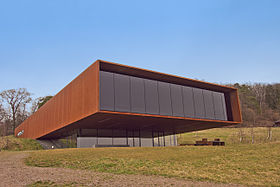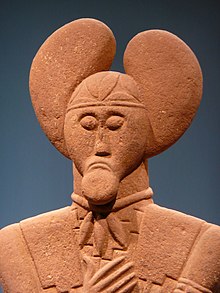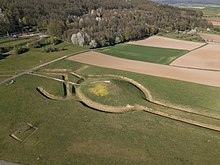Celtic world on the Glauberg
 Museum building |
|
| Data | |
|---|---|
| place |
Glauburg |
| Art |
archaeological museum
|
| architect | Kada Wittfeld |
| opening | 2011 |
| operator |
Archaeological State Museum Hessen
|
| management |
Vera Rupp
|
| Website | |
| ISIL | DE-MUS-243712 |
The Celtic World at Glauberg is an archaeological museum and research center with a focus on the Celtic period in the community of Glauburg in the Wetterau district in Hesse . The museum is one of two houses of the State Archaeological Museum Hessen . The complex also includes an archaeological park and a center for research into the Celts and the Iron Age . The focus of the exhibition is the “Celtic Prince of Glauberg”.
Geographical location
The Celtic world on the Glauberg is located on the southwest slope of the widely visible Glauberg , a 270 m high, flat ridge made of basalt . It was settled over many prehistoric epochs up to the Middle Ages and in pre-Roman times it had a fortified Celtic hilltop settlement . The sensational finds of richly furnished “ princely graves ” of three Celtic warriors from the late 5th century BC. BC and above all the statue of a warrior, the Celtic prince of Glauberg , completely preserved down to the feet , were the starting point for the decision to build a museum and research center here. The location was chosen in order to be able to present the original finds in the middle of the spacious, 37 hectare Celtic complex in a unit of museum and archaeological park.
museum
building
The museum building is a cubic structure clad with 6 × 2 meter panels made of Corten steel with a rectangular floor plan. Its entrance is on the southwest side of the glazed museum café below the structure. From here a staircase leads up to the actual museum. The southeast side of the building, which protrudes far over the café below, has a wide window front that provides a view of the excavation site with the burial mound. There is a viewing platform on the roof of the museum , which is accessible from the museum via a staircase.
An architectural competition preceded the construction of the museum. The Kada Wittfeld office of the architects led by Professor Klaus Kada and Gerhard Wittfeld and, together with the office of Club L94 Landscape Architects, convinced the judges. The design was implemented in 2009–2011 and received several awards. He received the "Exemplary Buildings in the State of Hesse 2011" award from the Hessian Ministry of Finance and the Hesse Chamber of Architects and Town Planners , which was entitled "Quality solutions for tourism, leisure and recreation", and a German Steel Construction Award 2012. The planning the exhibition architecture was announced as a competition. The Kada Wittfeld office was also commissioned to carry out the project, which ensured a unity of construction and design of the exhibition modules.
Permanent exhibition
The museum opened on May 5, 2011 with its permanent exhibition. It presents original finds from the excavations of the Hessian state archeology in their historical and scientific context. The focus is on the outstanding finds from Glauberg, in particular the 1.86-meter-tall, fully plastic figure of the "Celtic Prince", which came to light when the circular moat around the large burial mound was uncovered. It shows jewelry and weapons that are very similar to those that the warrior was equipped with in Tomb 1, which was excavated in the area immediately in front of the museum. The exhibition shows insights into various facets of Celtic culture based on the current state of research on the Celtic era and the Glauberg. The aim of the Celtic world on Glauberg is to build a Celtic ruler's seat from the 5th century BC. To make it comprehensively tangible.
Special exhibitions
- 2017: meal! - Diet among the Celts
- 2018: Myth of the Celts? Searching for clues in Europe
Archaeological Park
The Archaeological Park is a 370,000 m² outdoor area directly adjacent to the museum. On the one hand, it occupies the 20 hectare summit of the Glauberg, the area that supported the Celtic hilltop settlement and the medieval town complex. The visible and hidden archaeological relics are explained on an archaeological-cultural-historical circular hiking trail.
On the other hand, the open-air area extends below the museum, the large glass facade of which is directed towards the large Celtic burial mound 1, which has been reconstructed in its original position, with the subsequent so-called “processional street”, which is accompanied by moats. In 1987 the traces of a circular moat, relics of the burial mound, were discovered during an overflight. A second, also uncovered burial mound with the burial of a Celtic warrior was determined by geomagnetic research that was carried out in the wide area around the Glauberg.
Research Center
The research center, which is still under construction, forms the third pillar of the "Celtic World on Glauberg". Its connection to the museum makes the facility, which focuses on the pre-Roman Iron Age, unique in the German museum landscape. One of the tasks of the research center is to research the Glauberg and its surroundings and to present the knowledge gained in the museum. In addition, his assignment also includes the planning, support, implementation and networking of regional and international research projects on the pre-Roman Iron Age in Hesse. Until the end of 2015, the head of the research center was Dr. Ines Balzer. After moving to the German Archaeological Institute in Rome , Dr. Axel G. Posluschny, who between 2004 and 2010 had already done research on the area around the Glauberg as part of the DFG- funded project "Early Centralization and Urbanization Processes. On the Genesis and Development of Early Celtic Princely Seats and their Territorial Surroundings".
In spring 2020, the responsible Hessian Ministry for Science and Art confirmed that a new building of the research center, which is currently only provisionally housed in office containers, is planned next to the museum.
organization
The Celtic World on Glauberg is one of the state archaeological museums in Hesse. In this connection it represents the Iron Age . Another archaeological state museum is the Saalburg Museum in Bad Homburg vor der Höhe for the Roman period . Organizationally, the Celtic world on Glauberg is part of "hessenARCHÄOLOGIE", a department of the State Office for Monument Preservation Hesse . The director of the museum and the archaeological park is the deputy state archaeologist Vera Rupp , who was district archaeologist for the Wetterau district until 2002.
research results
New knowledge was gained on the sociology of the Celtic period.
literature
- Holger Baitinger u. Bernhard Pinsker (ed.), The Riddle of the Celts from Glauberg: Faith - Myth - Reality . Exhibition by the State of Hesse in the Schirn-Kunsthalle Frankfurt, May 24 to September 1, 2002 (Stuttgart 2002).
- Holger Baitinger, Der Glauberg - a princely seat of the late Hallstatt / early La Tène period in Hesse. Materials on the prehistory and early history of Hesse 26 (= Glauberg Studies 1) (Wiesbaden 2010).
- Egon Schallmayer u. Katharina von Kurzynski (Ed.): Archeology and Politics. Archaeological excavations of the 30s and 40s of the 20th century in a contemporary historical context. International conference on the occasion of "75 years of excavations on the Glauberg" 16. – 17. October 2008 in Nidda-Bad Salzhausen . Glauberg research 1 = Find reports from Hessen Supplement 7. Wiesbaden 2011.
- Katharina von Kurzynski u. Ines Balzer: The Celtic world on Glauberg. Museum - Archaeological Park - Research Center . In: Antike Welt 3 (2011), pp. 46–49.
- Ines Balzer: Research - network - convey. The research center of the "Celtic World on Glauberg" . In: Egon Schallmayer (Ed.): New start. Hessian State Archeology 2001-2011: Concept - Topics - Perspectives . In: HessenARCHÄOLOGIE, special volume 2 (2012), pp. 121–126.
- Keltenwelt am Glauberg (Ed.): 2500 years later. The Glauberg project = Glauberg writings 1. Glauburg-Glauberg 2012.
- Katharina von Kurzynski: The Celtic world on Glauberg. An archaeological museum in Hesse . In: Archäologisches Nachrichtenblatt 17/3 (2012), pp. 274–279.
- Fritz-Rudolf Herrmann u. Holger Baitinger, The Glauberg on the eastern edge of the Wetterau. Leaflet for the fortified hilltop settlement and the early Celtic princely graves near Glauburg-Glauberg, Wetteraukreis . Archaeological Monuments in Hesse 51 (Wiesbaden 2012).
- Ralf Ferdinand Broekman u. Olaf Winkler: The Celtic Museum at the Glauberg / The Celtic Museum at the Glauberg . Wuppertal 2012, ISBN 978-3-928766-99-9 .
- Eveline Grönke: Keltenmuseum am Glauberg receives award as part of the German Steel Construction Prize 2012 . In: Monument Preservation and Cultural History 1/2013, p. 38.
- Leif Hansen u. Christopher FE Pare , investigations in the area around the Glauberg. On the genesis and development of a prince's seat from the early La Tène period in the eastern Wetterau. Materials on the prehistory and early history of Hesse 28 (= Glauberg Studies 2) (Wiesbaden 2016).
- Udo Recker u. Vera Rupp (Ed.), The “Prince's Graves” from Glauberg: Salvage - Restoration - Textile Research. Materials on the prehistory and early history of Hesse 29 (= Glauberg Studies 3) (Wiesbaden 2018).
- Axel G. Posluschny, Does fortified always equate to defensive? Some thoughts on the fortification systems of the Glauberg hillfort . In: Tanja Romankiewicz, Manuel Fernández-Götz, Gary Lock u. Olivier Büchsenschütz (Ed.), Enclosing Space, Opening New Ground: Iron Age Studies from Scotland to Mainland Europe (Oxford 2019) pp. 9–18.
- Axel G. Posluschny et al. Ruth Beusing, Space as the Stage: Understanding the Sacred Landscape around the early Celtic Hillfort of the Glauberg . Open Archeology 5, Special Issue "Unlocking Sacred Landscapes: Digital Humanities and Ritual Space", 1, 2019, pp. 365–382 ( https://www.degruyter.com/view/j/opar.2019.5.issue-1/ opar-2019-0023 / opar-2019-0023.xml ).
Web links
- Website of the Keltenwelt am Glauberg
- Celtic world on the Glauberg . In: Museen-in-Hessen.de
- Celtic world on the Glauberg . In: Website of the Hessian Ministry for Science and Art
- Archaeological State Museum Hessen (ALMhessen) - Celtic World on Glauberg
Individual evidence
- ↑ Project: "Keltenwelt am Glauberg" on the website of Lummel GmbH & Co. KG (PDF; 2.07 MB)
- ↑ Celtic Museum on Glauberg, Glauburg , Award for exemplary buildings in the state of Hesse 2011.
- ↑ Eveline Grönke: Keltenmuseum am Glauberg receives award as part of the German Steel Construction Prize 2012 . In: Monument Preservation and Cultural History 1/2013, p. 38.
- ↑ A home for the Wetterau Celts . FAZ.NET . Retrieved May 5, 2011.
- ↑ Mead for sociability and mistletoe against ulcers in FAZ from June 27, 2017, page 40
- ↑ Norbert Buthmann, Martin Posselt, Benno Zickgraf: The spatial dimension. Geomagnetic prospecting . In: Holger Baitinger, Bernhard Pinsker (Hrsg.): The riddle of the Celts from Glauberg: Faith - Myth - Reality. Exhibition by the State of Hesse in the Schirn-Kunsthalle Frankfurt, May 24th to September 1st, 2002 . Theiss-Verlag, Stuttgart 2002, ISBN 978-3-8062-1592-2 , p. 108-113 .
- ↑ New head of the research center of the Celtic world on Glauberg. In: articles.hessen-archaeologie.de. Retrieved May 30, 2016 .
- ↑ Researchers in Glauburg stay on the mountain. February 28, 2020, accessed August 3, 2020 .
- ^ Glauberg: Advance laurels for the new head of the Celtic world. ( Memento from March 9, 2014 in the Internet Archive ) FAZ.net. Retrieved May 29, 2011.
- ↑ Leif Hansen et al. Christopher FE Pare , investigations in the area around the Glauberg. On the genesis and development of a prince's seat from the early La Tène period in the eastern Wetterau. Materials on the prehistory and early history of Hesse 28 (= Glauberg Studies 2) (Wiesbaden 2016).
- ↑ Leif Hansen, Christopher Pare: First results of new investigations in the area of the Glauberg . Eberhard Karls University of Tübingen . May 2005. Retrieved August 11, 2017.
- ↑ Axel G. Posluschny, Ruth Beusing: Space as the Stage: Understanding the Sacred Landscape around the early Celtic Hillfort of the Glauberg . In: Open Archeology 5, Special Issue "Unlocking Sacred Landscapes: Digital Humanities and Ritual Space . Volume 2019 , no. 1 , 2019, p. 365-382 , doi : 10.1515 / Mopar-2019-0023 ( degruyter.com ).



